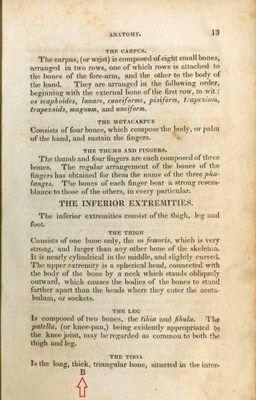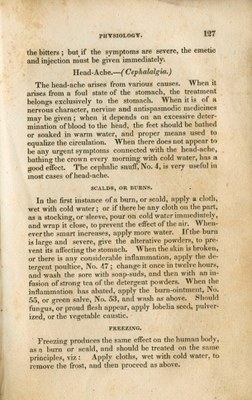
Plan your visit
From the Cataloger’s Desk: Signatures and Science
January 5, 2017

In the spring of 2012, I graduated from Indiana University’s Master of Library Science program with a specialization in rare books and manuscripts librarianship. The courses were fascinating, and now, I am lucky to put my education to good use as the cataloger of Printed Collections here at the IHS library. I recently cataloged a book published in 1836, titled The Domestic Physician, and Family Assistant, in Four Parts. Not only is the subject matter intriguing, but it took me back to my descriptive bibliography class and lessons on signatures.
When I mention signatures, you probably assume that I am referring to someone’s autograph, perhaps belonging to the author or a previous owner. This is a fair assumption, but incorrect. In this case, I am referring to the letters printed in the bottom margin of the first leaf of each gathering or section of the book. Signatures normally run from A-Z, and if the whole alphabet is used, they continue with double letters, such as AA or Aa.
So, was there a point to signatures? Yes! Signatures served as a guide to bookbinders, ensuring that books were assembled correctly. And, are signatures important today? Again, yes! Signatures are used by librarians and book collectors for identification purposes. The information they provide can make a significant difference in a book’s value, both historically and monetarily.
Sometimes, formulating and understanding signatures is simple. For example, with The Domestic Physician, they are A-M. Translation: Each gathering of the book consists of six leaves, and only the letters A-M are used. Other times, signatures look like really scary algebra equations! I recently came across this example in another institution’s catalog: A_ b c_ [chi]1 B-E F_ _[chi]1 _B-D _E(_E2+[chi]1) _F G(G5+chi1) H I(I3+chi1) K-N _chi1 O-Y Z. Yikes!
Apart from the signatures, the content of this book also piqued my interest. It is one of many the IHS library holds pertaining to science and medicine. It is fascinating, and sometimes frightening, to read about medical issues and how they were treated so many years ago. The Domestic Physician is divided into four parts: (I) A short system of anatomy, (II) On materia medica, or a description of medicinal vegetables, (III) On pharmacy, or the preparation of medicines, and (IV) On physiology, or the description and treatment of diseases.
The second part is full of all sorts of fun facts relating to plants and herbs. Here are just a few examples:
“The dandelion is a popular remedy for diseases of the liver and spleen, and is highly beneficial in jaundice and hypochondria.”
“Spear-mint is diuretic, sudorific, and anti-emetic; the infusion drank allays the irritability of the stomach, and stops vomiting.”
“Ginger is … very useful in colds, flatulent colics, laxity and debility of the intestines. It promotes circulation, and relieves pain.”
“Rhubarb is … very valuable combined with soda, in neutralizing the acidity of the stomach.”

Who knew?! The fourth part makes for enjoyable reading, too. As a sufferer of chronic headaches, I thought it might be fun to see what treatments were recommended in 1836. The next time I feel one starting, perhaps I will soak my feet in warm water, or bathe the crown of my head with cold water!
If you are interested in learning more about signatures and how old books were bound, or reading about the practice of medicine in the 19th century, this is the book for you!
The catalog record for The Domestic Physician, and Family Assistant, in Four Partscan be found here.








